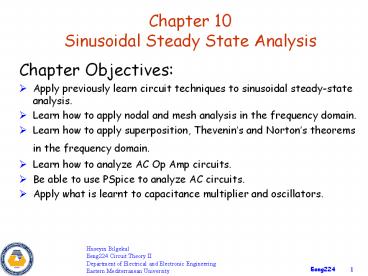Chapter 10 Sinusoidal Steady State Analysis - PowerPoint PPT Presentation
1 / 20
Title:
Chapter 10 Sinusoidal Steady State Analysis
Description:
Title: No Slide Title Author: McGraw-Hill Higher Education Last modified by: Dau Created Date: 4/20/1999 2:51:50 PM Document presentation format: On-screen Show – PowerPoint PPT presentation
Number of Views:207
Avg rating:3.0/5.0
Title: Chapter 10 Sinusoidal Steady State Analysis
1
Chapter 10Sinusoidal Steady State Analysis
- Chapter Objectives
- Apply previously learn circuit techniques to
sinusoidal steady-state analysis. - Learn how to apply nodal and mesh analysis in the
frequency domain. - Learn how to apply superposition, Thevenins and
Nortons theorems in the frequency domain. - Learn how to analyze AC Op Amp circuits.
- Be able to use PSpice to analyze AC circuits.
- Apply what is learnt to capacitance multiplier
and oscillators.
Huseyin Bilgekul Eeng224 Circuit Theory
II Department of Electrical and Electronic
Engineering Eastern Mediterranean University
2
Transform a voltage source in series with an
impedance to a current source in parallel
with an impedance for simplification or vice
versa.
Source Transformation
3
Source Transformation
- Practice Problem 10.4 Calculate the current Io
If we transform the current source to a voltage
source, we obtain the circuit shown in Fig. (a).
4
Source Transformation
- Practice Problem 10.4 Calculate the current Io
5
Thevenin Equivalent Circuit
- Thévenins theorem, as stated for sinusoidal AC
circuits, is changed only to include the term
impedance instead of resistance. - Any two-terminal linear ac network can be
replaced with an equivalent circuit consisting of
a voltage source and an impedance in series. - VTh is the Open circuit voltage between the
terminals a-b. - ZTh is the impedance seen from the terminals
when the independent sources are set to
zero.
6
Norton Equivalent Circuit
- The linear circuit is replaced by a current
source in parallel with an impedance. IN is
the Short circuit current flowing between the
terminals a-b when the terminals are short
circuited.
- Thevenin and Norton equivalents are related by
7
Thevenin Equivalent Circuit
P.P.10.8 Thevenin Equivalent At terminals a-b
8
Thevenin Equivalent Circuit
P.P.10.9 Thevenin and Norton Equivalent for
Circuits with Dependent Sources
To find Vth , consider the circuit in Fig. (a).
9
Thevenin Equivalent Circuit
P.P.10.9 Thevenin and Norton Equivalent for
Circuits with Dependent Sources
10
Thevenin Equivalent Circuit
P.P.10.9 Thevenin and Norton Equivalent for
Circuits with Dependent Sources
11
Thevenin Equivalent Circuit
P.P.10.9 Thevenin and Norton Equivalent for
Circuits with Dependent Sources
Since there is a dependent source, we can find
the impedance by inserting a voltage source and
calculating the current supplied by the source
from the terminals a-b.
12
OP Amp AC Circuits
- Practice Problem 10.11 Calculate vo and current
io
The frequency domain equivalent circuit.
13
OP Amp AC Circuits
- Practice Problem 10.11 Calculate vo and current
io
14
OP Amp AC Circuits
- Practice Problem 10.11 Calculate vo and current
io
15
Capacitance multiplier The circuit acts as an
equivalent capacitance Ceq
OP Amp Capacitance Multiplier Circuit
16
Oscillators
- An oscillator is a circuit that produces an AC
waveform as output when powered by a DC input
(The OP AMP circuit needs DC to operate). - A circuit will oscillate if the following
criteria (BARKHAUSEN) is satisfied. - The overall gain of the oscillator must be unity
or greater. - The overall phase shift from the input to ouput
and back to input must be zero.
17
Oscillators
- An oscillator is a circuit that produces an AC
waveform as output when powered by a DC input
(The OP AMP circuit needs DC to operate).
Produce overall gain greater than 1
- INPUT
OUTPUT
INPUT
Phase shift circuit to produce 180 degree shift
18
Assignment to be Submitted
Vo
V2
- Construct the PSpice schemmatic of the oscillator
shown Prob. 10.91 from the textbook which is also
shown above. - Display the oscilloscope AC waveforms of V2 and
Vo to show the phase relationship. - Submit the printout of your circuit schemmatic
and the oscilloscope waveforms of V2 and Vo as
shown in the next page for a similar circuit. - Do you obtain the required phase shift and the
oscillation frequency? If not it will not
oscillate to produce a pure sine wave. - Submission date 21 March 2007.
- The analytic solution is given in the next page
to help your simulation.
19
Assignment (Analytic Solution)
Chapter 10, Solution 91.
voltage at the noninverting terminal of the op
amp
output voltage of the op amp
For this to be purely real,
At oscillation,
This must be compensated for by
20
Similar Oscillator as the Assignment































